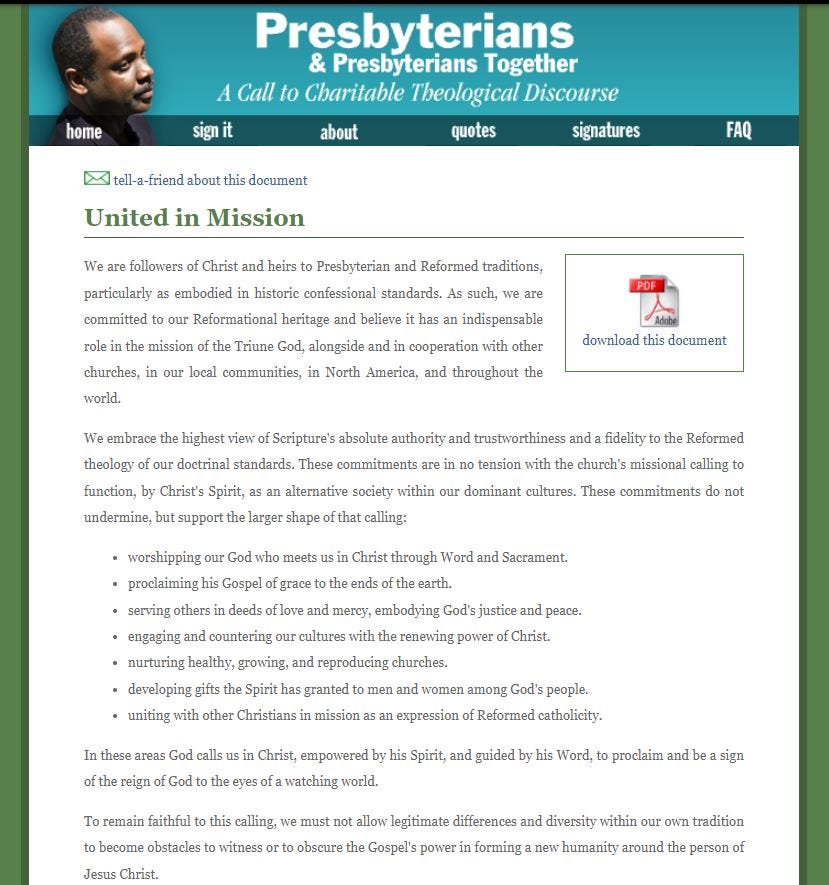Theological Trajectory & Ecclesial History
Where are the PCA signers of a 2006 plea for latitude now?
SOMETIMES HISTORY HIDES or whispers; sometimes it shouts or shines a light. Its suggestions are never as simple as they first appear and are always subject to revision, but are never without value. A particular historical moment in the presbyterian and Reformed (to be fair, mostly PCA) churches in 2006 (preserved here) is worth re-examining for what it reveals about where many presbyterian pursuers of peace and latitude were headed and where they are now.
THE CONTROVERSY SURROUNDING FEDERAL VISION1 occasioned an open letter 16 years ago. Though the words “federal” and “vision” never appear in the letter’s text, no one doubts that the debate2 and ecclesial cases associated with the Federal Vision’s aberrant views of church, sacraments, and justification precipitated the letter. The 220 or so signatories of Presbyterians and Presbyterians Together (a title inspired by a previous decade’s Evangelicals and Catholics Together3) believed the Federal Vision was not worth fighting over…or at least not with a level of intensity above that of a toddler pillow fight.
John Frame, one of the bigger names to sign on, wrote this:
“For many years I have felt that Presbyterians have wasted valuable time debating one another, time that could better be spent in worship, evangelism, and nurture. Pure doctrine is important, but total unanimity on every disputable issue is impossible, and that is not required by Scripture. So we need to be more careful about our priorities. We also need to take much greater care to be fair and gracious to one another when debates do arise. The principles expressed by the Presbyterians Together document give us biblical guidance in this area.”
The range of signers of this “inter-denominational” document was interesting. About 150 of the 220 had PCA connections; 17 were from the Communion of Reformed Evangelical Churches (CREC—the Doug Wilson-spawned denomination that embraced Federal Vision). Seven signatories were from the Orthodox Presbyterian Church (OPC), three from the United Reformed Churches in North America (URNCA), and two (stunningly) were from the mainline PCUSA. Stay tuned: More stunning PCUSA news is coming below.
More interesting to us is the question of where the PCA signatories are today. We randomly selected 304 names of PCA-associated ministers, interns, or Covenant Theological Seminary students from the list and looked them up. Here’s what we found:
15 of our 30-person sample are still in the PCA or stayed in the PCA until they retired or died. This is pretty impressive given the high burnout rate for pastors.
3 of 30 are out of ministry, including one who was arrested for a serious offense while in ministry.
9 of 30 are now in denominations that are either egalitarian or to the PCA’s left doctrinally, at least on the Reformed confessional spectrum: Of the nine, three joined the EPC or ECO, which we might call midline denominations since they are mostly egalitarian and made up of those who left the mainline much later than did the founders of the PCA. Two joined the Anglican Church in North America (ACNA), a group so difficult to pin down that we will not even attempt to further categorize them. ACNA, like the EPC, is somewhat egalitarian—a state some might consider as dubious and transitory as “somewhat pregnant.” Most surprisingly, four former PCA ministers joined liberal mainline denominations—the PCUSA and the Episcopal Church.
This sample suggests those troubled by controversy, jealous (or zealous) for latitude, or supportive of the Federal Vision doctrines generally exited stage left. We suspect the leavers were more concerned with freedom of doctrine and practice generally rather than being big fans of paedocommunion or doctrine of justification “innovations” (two hallmarks of the Federal Vision) specifically. As we have often put it, this is the ethos of “latitude for thee means latitude for me.”
The actions of the last few General Assemblies have arguably tightened up things to a degree that was likely unimaginable in 2006. This suggests (as does recent data) that defections to the new center of Reformed Evangelicalism (a zone demonstrably to the left of today’s PCA in doctrine and polity) will continue.
ONE USED TO HEAR about megatrends in society (maybe TED talkers still speak of them). Today, talk of metanarratives is more common, and in the PCA there are competing metanarratives. One says a PCA born broadly evangelical, somewhat Reformed, and diverse (if not confused) in practice ought to always maintain a big tent ethos. Another recognizes the “it’s complicated” explanation of the PCA’s genesis but expects her inescapable confessional and polity genetics to produce a mature organism that tends to order and a distinctively Reformed character. The questions: Which way does the long arc of PCA history bend, and in which direction do her ministers tend? Our quick look at a snapshot from 2006 and its grainy subjects’ subsequent history may (or may not) help answer those questions.
If you don’t believe the Federal Vision was a definable thing or if you believe that it was no big deal, I suggest you stop reading at this point and unsubscribe. FV was defined and condemned (or warned against) by several NAPARC denominations, including the PCA.
This may have been the first Reformed controversy that played out mostly online.
Also known as ECT. https://en.wikipedia.org/wiki/Evangelicals_and_Catholics_Together
30 out of 150 is what pollsters call a big sample. The names were not cherry-picked. The known paths of several names not part of the sample suggest that the randomly chosen 30 were representative of the 150.



